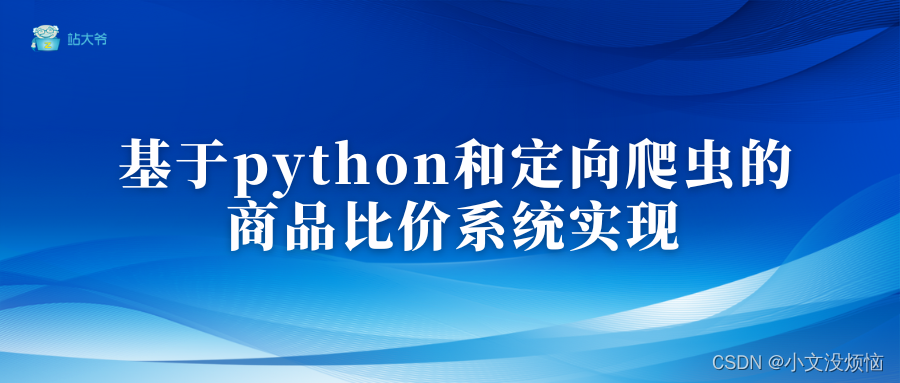基于python和定向爬虫的商品比价系统实现
目录

前言
商品比价系统是一种可以帮助用户快速找到最优价格商品的系统。本文将介绍如何使用python和定向爬虫来构建一个基于商品比价的系统,并提供相关代码。
一、系统设计
1. 系统需求分析
在构建商品比价系统之前,我们首先需要明确系统的功能需求。通过对市场上已有的商品比价系统进行调研,我们可以总结出以下主要功能需求:
- 用户可以输入商品关键词进行搜索。
- 系统能够从多个电商平台上获取对应商品的价格信息。
- 系统能够对比不同电商平台上的商品价格,并给出最低价格的推荐。
- 系统需要能够支持多线程爬取,提高抓取效率。
基于以上需求,我们可以设计系统的基本架构如下:
输入商品关键词 ---> 系统爬取多个电商平台的商品信息 ---> 系统对商品价格进行比较 ---> 系统输出最低价格商品推荐
2. 系统设计思路
根据系统需求,我们可以将系统的设计思路分为以下几个步骤:
- 根据用户输入的商品关键词,通过爬虫获取多个电商平台上的商品信息。
- 对获取到的商品信息进行解析,提取商品名称、价格等关键信息。
- 对比不同电商平台上的商品价格,找出最低价格的商品。
- 将最低价格的商品信息展示给用户。
二、系统实现
1. 爬虫部分
我们可以使用python的`requests`库来发送网络请求,以获取电商平台上的商品信息。以下是一个简单的爬虫示例代码:
import requests
def get_product_info(keyword):
? ? url = 'http://www.example.com/search?q=' + keyword
? ??
? ? # 发送网络请求获取页面内容
? ? response = requests.get(url)
? ? content = response.text
? ??
? ? # 解析页面内容,提取商品信息
? ? # TODO: 解析商品名称、价格等信息
? ??
? ? return product_info在实际应用中,我们需要通过分析电商网页的HTML结构,使用合适的解析库(如`BeautifulSoup`或`lxml`)来提取商品信息。
2. 比价部分
比价部分主要是对比获取到的不同电商平台上的商品价格,并找出最低价格的商品。以下是一个简单的比价示例代码:
def compare_prices(products):
? ? min_price = float('inf')
? ? min_product = None
? ??
? ? for product in products:
? ? ? ? if product.price < min_price:
? ? ? ? ? ? min_price = product.price
? ? ? ? ? ? min_product = product
? ??
? ? return min_product在实际应用中,我们需要将获取到的商品信息封装成一个`Product`类,以方便数据的处理和比较。
3. 完整系统代码
下面是一个简化的商品比价系统的完整代码:
import requests
class Product:
? ? def __init__(self, name, price):
? ? ? ? self.name = name
? ? ? ? self.price = price
def get_product_info(keyword):
? ? url = 'http://www.example.com/search?q=' + keyword
? ??
? ? # 发送网络请求获取页面内容
? ? response = requests.get(url)
? ? content = response.text
? ??
? ? # 解析页面内容,提取商品信息
? ? # TODO: 解析商品名称、价格等信息
? ??
? ? return product_list
def compare_prices(products):
? ? min_price = float('inf')
? ? min_product = None
? ??
? ? for product in products:
? ? ? ? if product.price < min_price:
? ? ? ? ? ? min_price = product.price
? ? ? ? ? ? min_product = product
? ??
? ? return min_product
def main():
? ? keyword = input("请输入要搜索的商品关键词:")
? ? products = get_product_info(keyword)
? ? min_product = compare_prices(products)
? ??
? ? print("最低价格的商品是:", min_product.name)
? ? print("价格:", min_product.price)
if __name__ == '__main__':
? ? main()三、系统优化
1. 多线程爬取
为了提高商品信息的获取效率,我们可以使用多线程的方式来进行商品信息的爬取。以下是一个简单的多线程爬虫示例代码:
import threading
import requests
def get_product_info(keyword):
? ? url = 'http://www.example.com/search?q=' + keyword
? ??
? ? # 发送网络请求获取页面内容
? ? response = requests.get(url)
? ? content = response.text
? ??
? ? # 解析页面内容,提取商品信息
? ? # TODO: 解析商品名称、价格等信息
? ??
? ? return product_list
def main():
? ? keyword = input("请输入要搜索的商品关键词:")
? ??
? ? # 创建多个线程进行爬取
? ? threads = []
? ? for i in range(5):
? ? ? ? t = threading.Thread(target=get_product_info, args=(keyword,))
? ? ? ? threads.append(t)
? ? ? ? t.start()
? ??
? ? # 等待所有线程执行完毕
? ? for t in threads:
? ? ? ? t.join()
? ??
? ? # TODO: 对比商品价格,输出最低价格的商品信息
if __name__ == '__main__':
? ? main()通过使用多线程爬取,可以显著提高商品信息的获取速度,从而提升系统的响应速度。
2. 引入数据库
为了提高系统的可扩展性和数据的存储和管理,我们可以引入数据库来存储爬取到的商品信息。以下是一个使用SQLite数据库的示例代码:
import sqlite3
def save_product_info(products):
? ? conn = sqlite3.connect('products.db')
? ? cursor = conn.cursor()
? ??
? ? # 创建商品信息表
? ? cursor.execute('''
? ? ? ? CREATE TABLE IF NOT EXISTS product_info (
? ? ? ? ? ? id INTEGER PRIMARY KEY AUTOINCREMENT,
? ? ? ? ? ? name TEXT,
? ? ? ? ? ? price REAL
? ? ? ? )
? ? ''')
? ??
? ? # 插入商品信息
? ? for product in products:
? ? ? ? cursor.execute('INSERT INTO product_info (name, price) VALUES (?, ?)', (product.name, product.price))
? ??
? ? conn.commit()
? ? conn.close()
def main():
? ? # 爬取商品信息
? ? products = get_product_info(keyword)
? ??
? ? # 保存商品信息到数据库
? ? save_product_info(products)
if __name__ == '__main__':
? ? main()通过使用数据库,我们可以方便地进行数据的存储、查询和管理,提高系统的可扩展性和稳定性。
四、总结
本文介绍了如何使用python和定向爬虫来构建一个基于商品比价的系统,并提供了相关代码。通过对系统的设计思路进行分析和实现,我们可以从多个电商平台上获取商品信息,并对比商品价格,从而实现最低价格的商品推荐。此外,我们还介绍了如何通过使用多线程和数据库来优化系统的性能和可扩展性。希望本文能够帮助读者理解和实践商品比价系统的构建过程,同时也能够提供一些启发和思路,以便读者能够根据自己的需求进行系统的定制和优化。
本文来自互联网用户投稿,该文观点仅代表作者本人,不代表本站立场。本站仅提供信息存储空间服务,不拥有所有权,不承担相关法律责任。 如若内容造成侵权/违法违规/事实不符,请联系我的编程经验分享网邮箱:chenni525@qq.com进行投诉反馈,一经查实,立即删除!
- Python教程
- 深入理解 MySQL 中的 HAVING 关键字和聚合函数
- Qt之QChar编码(1)
- MyBatis入门基础篇
- 用Python脚本实现FFmpeg批量转换
- 大数据质量管制规范示例
- Verilog 和 System Verilog 的区别
- Java集合/泛型篇----第六篇
- Unity中ShaderGraph下获取主灯
- 设计模式(4)--对象行为(7)--观察者
- 发布订阅模式和观察者模式详解
- 服装店收银系统 助力完善线上线下方案
- 【算法题】25. K 个一组翻转链表
- 2023我的 python 编程之旅:从入门到熟练我用了5年,从构思到发文只用了3个月!
- navicat for oracle